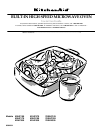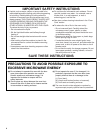
4
SAVE THESE INSTRUCTIONS
IMPORTANT SAFETY INSTRUCTIONS
See door surface cleaning instructions in the “Oven
Care” section.
To reduce the risk of fire in the oven cavity:
– Do not overcook food. Carefully attend the
microwave oven if paper, plastic, or other
combustible materials are placed inside the oven
to facilitate cooking.
■
■
■
Do not store the microwave oven outdoors. Do not
use this product near water - for example, near a
kitchen sink, in a wet basement, or near a
swimming pool, and the like.
– Remove wire twist-ties from paper or plastic bags
before placing bags in oven.
– If materials inside the oven should ignite, keep
oven door closed, turn oven off, and disconnect the
power cord, or shut off power at the fuse or circuit
breaker panel.
– Do not use the cavity for storage purposes. Do not
leave paper products, cooking utensils, or food in
the cavity when not in use.
To reduce the risk of injury to persons:
■
Liquids, such as water, coffee, or tea are able to be
overheated beyond the boiling point without appearing
to be boiling. Visible bubbling or boiling when the
container is removed from the microwave oven is not
always present. THIS COULD RESULT IN VERY HOT
LIQUIDS SUDDENLY BOILING OVER WHEN THE
CONTAINER IS DISTURBED OR A SPOON OR
OTHER UTENSIL IS INSERTED INTO THE LIQUID.
– Do not overheat the liquid.
– Stir the liquid both before and halfway through
heating it.
– Do not use straight-sided containers with narrow
necks.
– After heating, allow the container to stand in the
microwave oven for a short time before removing
the container.
– Use extreme care when inserting a spoon or other
utensil into the container.
PRECAUTIONS TO AVOID POSSIBLE EXPOSURE TO
EXCESSIVE MICROWAVE ENERGY
(a) Do not attempt to operate this oven with the door
open since open-door operation can result in
harmful exposure to microwave energy. It is
important not to defeat or tamper with the
safety interlocks.
(b) Do not place any object between the oven front
face and the door or allow soil or cleaner residue
to accumulate on sealing surfaces.
(c) Do not operate the oven if it is damaged. It is
particularly important that the oven door close
properly and that there is no damage to the:
(1) Door (bent),
(2) Hinges and latches (broken or loosened),
(3) Door seals and sealing surfaces.
(d) The oven should not be adjusted or repaired by
anyone except properly qualified service personnel.


















